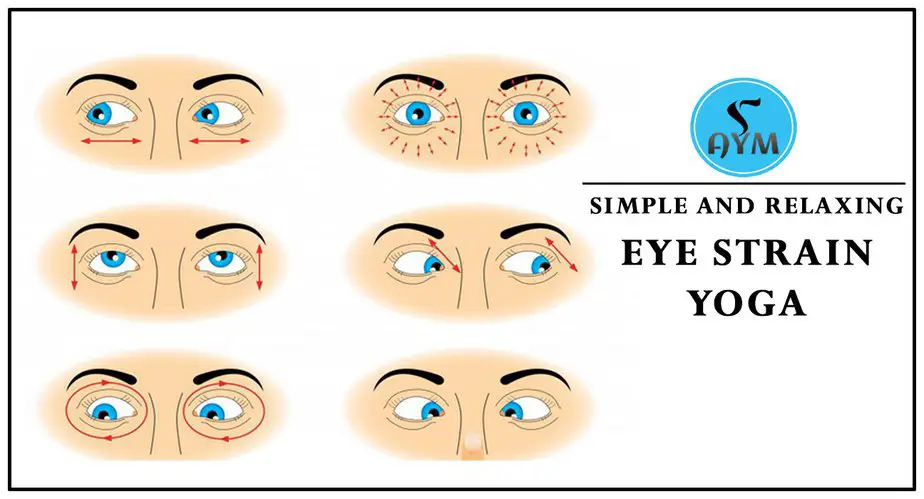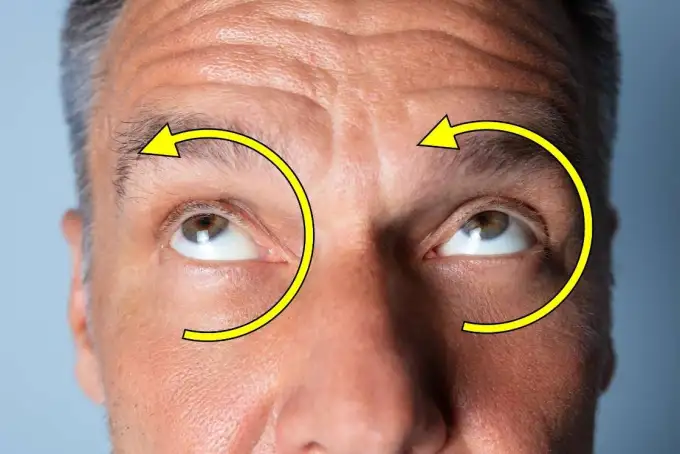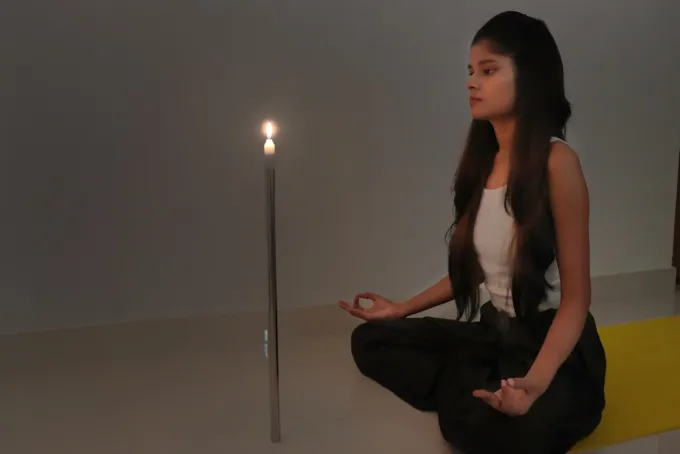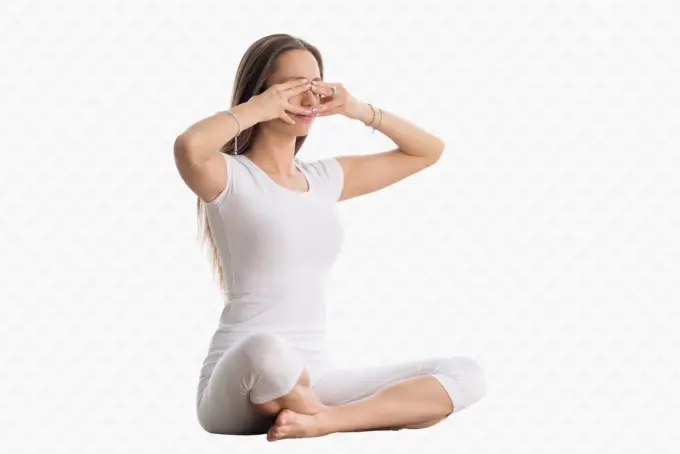Exercises to improve vision It would be too extreme to say that yoga eye exercises may remove spectacles. Yoga or any other eye exercise cannot be proven to be a reliable substitute for wearing glasses. Yoga eye exercises, however, might enhance your overall eye health, which might eventually reduce your need for spectacles. There is a remote possibility, but there are no concrete pieces of evidence.
What science says?
The influence of the yoga eye exercises will depend totally upon the cause and severity of the vision impairment. However, it has been scientifically proven that eye exercises do not harm the eye [efn_note] Di Noto P, Uta S, DeSouza JFX (2013) Eye Exercises Enhance Accuracy and Letter Recognition, but Not Reaction Time, in a Modified Rapid Serial Visual Presentation Task. PLoS ONE 8(3): e59244. https://doi.org/10.1371/journal.pone.0059244 [/efn_note]. The most common causes of vision impairment include Glaucoma, Trachoma, corneal opacity, diabetic retinopathy, age-related macular degeneration, cataracts, and uncorrected refractive errors.
Yoga eye exercises can control the pressure in the eye blood vessels, improve the function of the optic nerves, and repair the muscle cells that have been damaged in order to improve vision. Additionally, these activities help encourage healthy tear production, which is a crucial factor in the body’s ability to fight infections. All of these advantages work to improve your vision. Be aware that severe visual impairments cause significant ocular tissue damage that even yoga eye workouts cannot fully restore healing.
Some studies have shown that Trataka yoga Kriya on patients with refractive error has improved clarity of vision, contrast sensitivity, and fineness of object [efn_note] Gopinathan G, Dhiman KS, Manjusha R. A clinical study to evaluate the efficacy of Trataka Yoga Kriya and eye exercises (non-pharmacological methods) in the management of Timira (Ammetropia and Presbyopia). Ayu. 2012;33(4):543-546. doi:10.4103/0974-8520.110534 [/efn_note]. In average cases of vision impairment with symptoms like headache, ocular pain, fatigue, and watering, yoga exercises can improve vision and relieve symptoms by 26-50%.
One of the most important functions that eye yoga exercises provide which leads to many benefits, is that it reduces intraocular pressure (IOP) [efn_note] Galina D, Etsuo C, Takuhei S, et al. Immediate Effect of Yoga Exercises for Eyes on the Macular Thickness. Int J Yoga. 2020;13(3):223-226. doi:10.4103/ijoy.IJOY_28_20 [/efn_note]. Reduced intraocular pressure also helps in eliminating eye fatigue and reduces the chance of glaucoma. The yoga eye exercises also increase the ocular muscle efficiency that contributes to the reduction of fatigue [efn_note] Gupta SK, Aparna S. Effect of Yoga Ocular Exercises on Eye Fatigue. Int J Yoga. 2020;13(1):76-79. doi:10.4103/ijoy.IJOY_26_19 [/efn_note]
Yoga Benefits for Eyes
Yoga for the eyes can act as a very good preventive measure and supplement to support your conventional therapy. Eye yoga benefits the reception of the nerves in your eyes, the tenacity of your eye muscles, and blood flow to the vessels. These three functions collectively can prove beneficial to your eye health.
- Exercises to improve vision Yoga can help with computer eye strain. According to studies, doing eye yoga regularly can lessen the dryness, discomfort, and blurriness that frequent computer users experience.
- Exercises to improve vision Yoga develops quick, precise eye movements that make it easier for you to focus more quickly and clearly.
- Exercises to improve vision Yoga practice on a regular basis will increase the blood flow to your eyes, which will better nourish the light-sensitive cells. You will be able to see clearly in higher brightness and darkness thanks to this. Additionally, control the blood flow to your eyes and keep the ocular blood vessels’ pressure at an ideal level. Glaucoma progression may potentially be slowed by lower intraocular pressure.
- Your eyes’ optic nerves can be strengthened by yoga for better motor abilities.
- Yoga can provide your eyes with much-needed rest, allowing the little wear and tears in your eyes to recover.
- Yoga will improve your intellect, which will improve your brain’s capacity to process visual information. As a result, you’ll unconsciously pay more attention to what you see and process images more quickly and accurately.
- Yoga can also keep your eyes clean, moist, and oxygenated.
- Yoga’s deliberate eye motions in specific directions will improve your peripheral vision.
Exercises to Improve Eyesight
The yoga exercises for the eyes are very simple and easy. The yoga for eyes is free of exhaustion but what they do need is a conscious effort to execute perfection.
1. Palming

The light-sensitive eye cells can be stimulated to aim, which is a fantastic method to calm your eyes and give them a natural warm-up.
The blood flow in the eye will be especially increased by palming, increasing the nutrients available to the eye cells. Your eyes’ little wear and tears will heal if you palm. The pressure in your eye will eventually decrease if you palm.
- Sit quietly on a chair or in a cross-legged position that feels good to you.
- To refocus, take a few deep breaths.
- Close your eyes.
- Exercises to Improve Eyesight your hands should be vigorously rubbed against one another to create warmth.
- Exercises to Improve Eyesight place your hands over your eyes at this point and rub them vigorously to generate heat.
- Remove your hands once the heat dissipates.
- Continue this process 3-5 times.
- Do not forget to repeatedly squirt cold water into your closed eyes before beginning. Throughout the process, you must maintain a straight back, spine, and head.
2. Blinking

Exercises to Improve Eyesight yes, even something as basic as blinking is a workout. It’s also a really nice one. Do your eyes a favor and blink a few times the next time you are staring at the screen for more than 10 to 15 minutes.
Exercises to improve vision your eyes are moisturized, given oxygen, and the outermost layer of the eye is cleaned when you blink. Finally, your eye is lined with a fresh sheet of tears every time you blink, improving your vision.
- Sit comfortably on a chair or a cross-legged position.
- Blink 10 times very quickly.
- Then with your eyes closed, relax for 20 seconds. Breathe attentively.
- Repeat this process 4-5 times.
It’s crucial to make each blink you make while blinking a full blink. Your upper and lower eyelids will come into contact at that point. The intended results won’t be obtained otherwise.
3. Directional viewing
Your eye muscles will be strengthened for stability at the extremities by performing viewing exercises on all of your ocular peripheral edges. Your eye muscles will benefit greatly from this yoga, which can also improve your peripheral vision. Three different types of directional viewing are used: sideways looking, rotational viewing, and up-and-down gazing.
Sideways viewing

- With your head and spine straight, sit comfortably straight. Preferably sit cross-legged on the floor or in a chair.
- Make a fist with both of your hands raised up in front of you, thumbs pointing upward.
- Start by looking directly between your eyebrows, then move your focus to your left thumb, and finally back to your eyebrows.
- Look at your right thumb now, then back at the gap between your brows, and finally your left thumb.
- Hold your eyes for around 2 seconds at each location.
- 10–20 times, repeat this workout.
Exercises to Improve Eyesight exhale as you go sideways after taking a breath in the neutral positions. Additionally, widen the space between your hands to get higher acuity.
Up and down viewing

- Legs in front of you while you sit upright.
- Thumbs pointing upward, place both of your fists on your knees.
- Now slowly begin to raise your right thumb, keeping it in your line of sight as you do so.
- Keep your thumb raised while keeping your concentration fixed. Return to the starting position after climbing as high as your eyesight will allow.
- To finish one cycle, repeat each step with your left thumb as well.
- Practice 5 rounds in total.
Once you’ve finished this workout, unwind a little. Pace the movement of your thumb so that you can continue to breathe in during the ascent and out during the descent.
Rotational viewing

- On the floor or a chair, sit cross-legged and straight. Straight back, head, and spine.
- Put your right fist on your right knee and your left hand on your left knee. You should have your right thumb pointing up. Elbows should remain straight.
- Look at your right thumb in particular. Now, begin circling with your thumb. Keep your attention fixed on your right thumb while you make the circle.
- Make 5 counterclockwise and 5 clockwise turns. Next, do the same exact thing with your left thumb.
- It is important to avoid breaking your thumb while constructing the circles. The size of the circle can be changed to improve range training. When forming the upper arch, inhale, and when forming the lower arch, exhale.
4. Focus shift viewing

The ligaments and muscles responsible for the eye’s focus benefit greatly from focus shift watching. Our vision can get clearer with the help of this activity. The likelihood of developing nearsightedness and farsightedness can be decreased by this practice.
- Standing or sitting in a space with a clear view of the horizon is recommended.
- As close as you can focus, place your thumb next to the tip of your nose.
- Spend 10 seconds concentrating on the horizon, followed by 10 seconds concentrating on your thumb.
- Rest your eyes after performing this exercise 10 to 20 times.
- Inhale to focus on the near and exhale to focus on the distance. You can gradually reduce the time to 3 seconds each as your muscles get more well-trained.
5. Trataka

Trataka is a traditional yoga practice for the eyes that comes under the umbrella of yoga kriyas called Shatkarma.
In Trataka, you need to continuously and steadily at a fixed point and at a very close range. This yoga is excellent for training your nerves to be steady and gives you better control over eye movements. It also establishes synchronization between both eyes. Trataka can lower high myopic power.
- Lie back on the floor or on a comfortable chair.
- Place something with a pointed end or a burning candle about two feet away from where you are seated.
- Now, without blinking, focus both of your eyes on a single point, such as the candle’s flame or the pointed end.
- You can perform this exercise for as long as you can, but to begin with, attempt to count at least 100 times. Additionally, think of numbers to count rather than using a stopwatch. The concentration will be improved by counting numbers.
6. Bhramari Pranayama

One of the greatest pranayama exercises for the eyes is bhramari. This pranayama is ideal for the eyes because of the soothing humble bee sound and the way the hands are held. Your head and eyes may feel less pressure, strain, and tension as a result. This Pranayama also has a big impact on your neurological system, which is closely related to your eyes.
- Straighten your back and your head as you sit in a chair or on the floor with your legs crossed.
- Your thumbs should be on the aperture of your ear, and the rest of your fingers should be placed horizontally on your eyes.
- Inhale deeply, and then let out a sound like a bee humming.
- Repeat this process 5 times.
- Make sure you don’t press down your eyeballs hard. Instead of placing four fingers on the eye, you can place your index on the eye, the middle on the nose bridge, the ring above the upper lip, your little finger below the lower lip, and the thumb on your ear -the Shanmukhi mudra.
Tips For Eye Care:
Cold Spoon – Keep two spoons in the freezer overnight. Dab the backsides of your eyes the next day. It improves blood circulation.
Green tea bags – Soak the tea bags in cold water and keep them on your eyes for 15-20 minutes. The tannins in the tea will reduce inflammation and keep your eyes bright and healthy. home hacks to cool your eyes.
The above practices, yoga for eyes to remove glasses, and tips for eye care will help you get over any inconveniences you have with your eyes.
Can yoga improve eyesight?
People who practice eye yoga are often hoping to improve their vision, treat dry eye symptoms, and decrease eye strain. There’s no evidence to support the claim that eye yoga can correct conditions like astigmatism, nearsightedness, or farsightedness.
Which yoga is good for the eyes?
PALMING: Sit quietly with your eyes closed and take some deep breaths to relax. Rub the palms of your hands vigorously until they become warm and place the palms over your eyelids. Feel the warmth of the palms being transferred from onto the eyes and eye muscles relaxing.
Is Tratak good for the eyes?
The Tratak kriya strengthens eye muscles and improves vision and memory. It also helps in keeping insomnia at bay. Those who have sleeping difficulties should do Tratak daily without fail. It also strengthens the ability to concentrate.
What is Tratak ocular exercise?
After completing the Trataka exercise, palming or cupping the eyes is practiced. It is a technique for calming the eyes after eye movements. It is also used as a pre-eye-opening technique following meditation.
Can Tratak be harmful?
Yes, if done with excessive force or in a tense manner, you could harm your eyes. Whether you perform Tasrak on a dot, idol, image, candle, fire, sun, moon, star, or body of water doesn’t matter. Whatever the case, If you do it carelessly, you’ll harm your eyes.
How long should Tratak be done?
Timing. Going through all the steps of Tratak should last 10 to 30 minutes.
How does Tratak improve eyesight?
Trataka, also known as candle gazing, has many advantages. physical advantages. By releasing neurotic tension, this activity will assist in relaxing and strengthening the muscles surrounding the eyes.
Can we do Tratak before sleeping?
One of the most strongly advised practices for insomniacs is Track. It needs to be practiced before bed. Results could be felt after a month of training. Regular Tratak practice can be quite beneficial for people who have impaired eyesight or weak eye muscles.
Can you blink during Tratak?
Trataka commonly referred to as “yogic staring,” is a form of ancient meditation that also functions as an eye-cleansing procedure. … Bahiranga Trataka is the practice of maintaining a fixed stare on a single object and not blinking until the eyes itch or start to moisten.
Can Tratak improve myopia?
High myopes should avoid Tratak, while others should practice the technique without glasses. Additionally, wearing contacts while using the staring techniques is acceptable. Palming: To use this calming method, you must sit quietly with your eyes closed.
Who should not practice Trataka?
Enhances willpower, visualization, and intuition. People with psychic issues should not attempt this practice. Trataka should not be used by those who are prone to schizophrenia or hallucinations.
Can I do Tratak twice a day?
Well, there isn’t a set amount of time for performing Tratak. However, if you’re just starting out, practicing it for 3-5 minutes each day can help you focus better.
Which Yoga is good for eyesight?
Yoga eye exercises, often known as eye yoga, are movements that are intended to tone and condition the muscles that support your eyes. Eye yoga practitioners frequently seek to enhance their eyesight, cure dry eye symptoms, and lessen eye strain.
Is Tratak good for glaucoma?
By lowering IOP and problems linked to stress, Tratak kriya can be utilized as a non-pharmacological treatment to treat glaucoma and improve patients’ quality of life (QoL).
Can we do Tratak with specs?
Trataka enhances vision. Therefore, practice without your glasses. In order to see the image, the eyes will attempt to adjust.





















